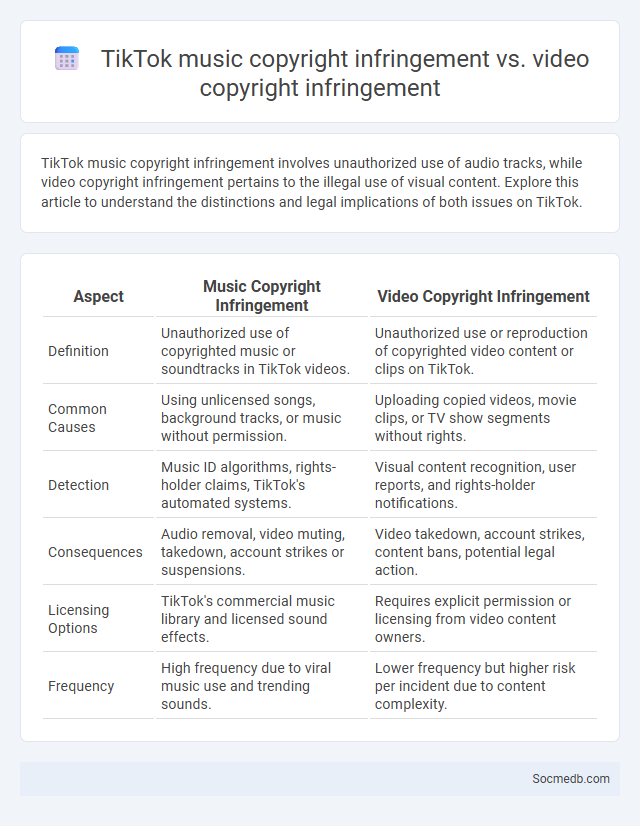
Photo illustration: TikTok music copyright infringement vs video copyright infringement
TikTok music copyright infringement involves unauthorized use of audio tracks, while video copyright infringement pertains to the illegal use of visual content. Explore this article to understand the distinctions and legal implications of both issues on TikTok.
Table of Comparison
| Aspect | Music Copyright Infringement | Video Copyright Infringement |
|---|---|---|
| Definition | Unauthorized use of copyrighted music or soundtracks in TikTok videos. | Unauthorized use or reproduction of copyrighted video content or clips on TikTok. |
| Common Causes | Using unlicensed songs, background tracks, or music without permission. | Uploading copied videos, movie clips, or TV show segments without rights. |
| Detection | Music ID algorithms, rights-holder claims, TikTok's automated systems. | Visual content recognition, user reports, and rights-holder notifications. |
| Consequences | Audio removal, video muting, takedown, account strikes or suspensions. | Video takedown, account strikes, content bans, potential legal action. |
| Licensing Options | TikTok's commercial music library and licensed sound effects. | Requires explicit permission or licensing from video content owners. |
| Frequency | High frequency due to viral music use and trending sounds. | Lower frequency but higher risk per incident due to content complexity. |
Understanding TikTok Music Copyright Infringement
TikTok music copyright infringement occurs when users upload videos containing copyrighted songs without proper authorization from the rights holders, leading to potential legal issues and content removal. Understanding TikTok's licensing agreements with major music labels can help You avoid infringing on copyrighted material by using approved sounds and music tracks available within the app. Protecting your content from copyright claims ensures smoother engagement and compliance with intellectual property laws on social media platforms.
What Constitutes Video Copyright Infringement on TikTok
Video copyright infringement on TikTok occurs when you use someone else's original video content without proper permission or licensing, including visuals, audio, or music. This includes reposting, editing, or distributing copyrighted clips, songs, or soundtracks in your TikTok videos without authorization. Understanding these guidelines ensures your content respects intellectual property rights and avoids takedown or legal issues.
Differences Between Music and Video Copyright Violations
Music copyright violations on social media primarily involve unauthorized use of audio tracks, often detected through automated content ID systems analyzing melody, lyrics, and sound patterns. Video copyright violations extend beyond audio to include visual elements such as film clips, animations, and graphics, requiring more complex monitoring tools that assess both image and sound for infringement. Understanding these distinctions helps you navigate content creation while avoiding potential copyright disputes on social platforms.
How TikTok Detects Copyright Infringement
TikTok detects copyright infringement using advanced artificial intelligence algorithms that scan uploaded content for matches against a vast database of copyrighted audio and video. The platform employs fingerprinting technology to identify copyrighted material by analyzing unique digital signatures embedded in music tracks and video clips. When unauthorized use is detected, TikTok automatically mutes, takes down, or restricts the content to comply with copyright laws and protect rights holders.
Legal Implications of Music vs Video Copyright Breaches
Social media platforms enforce strict copyright regulations to prevent unauthorized use of music and video content, with legal implications varying between these media types. Music copyright breaches often result in automated content removal, monetization claims, or account strikes under the Digital Millennium Copyright Act (DMCA), while video copyright violations can lead to more severe consequences including takedowns and potential lawsuits. Understanding your rights and obligations on social media can help you avoid costly legal penalties and maintain compliance with copyright laws.
Common Examples of Infringements on TikTok
Common examples of infringements on TikTok include unauthorized use of copyrighted music, trademark violations through counterfeit merchandise promotions, and breaches of privacy by sharing personal information without consent. Your account's content could be removed or penalized if it includes unlicensed videos or images, leading to potential legal consequences. Protect your presence by ensuring all shared media complies with TikTok's intellectual property and privacy guidelines.
TikTok’s Copyright Management System Explained
TikTok's Copyright Management System leverages advanced content identification technology to detect and manage copyrighted material across its platform. The system employs automated filters combined with human review to ensure compliance with copyright laws while safeguarding creators' rights. Your videos are scanned for potential infringements, allowing TikTok to efficiently address claims and protect original content.
How Creators Can Avoid Copyright Infringement
Creators can avoid copyright infringement by using original content or obtaining proper licenses for music, images, and videos in their social media posts. Utilizing royalty-free resources and crediting sources accurately ensures compliance with copyright laws and protects your account from strikes or bans. Implementing content recognition tools helps monitor and prevent unauthorized use, safeguarding your creative work.
Penalties for Copyright Infringement on TikTok
TikTok enforces strict penalties for copyright infringement, including video removal, account suspension, and permanent bans for repeat offenders. Content creators face automated detection systems that identify copyrighted music, videos, or images, leading to immediate takedown notices. Legal actions may follow serious violations, with TikTok collaborating with copyright holders to protect intellectual property rights.
Future Trends in Copyright Enforcement on TikTok
Future trends in copyright enforcement on TikTok emphasize advanced AI-driven content recognition systems capable of real-time detection and removal of infringing videos. The platform is expected to enhance collaboration with copyright holders through automated licensing agreements and blockchain technology to verify content ownership and usage rights. Increasing user transparency tools and stricter penalties for repeated violations will also shape TikTok's evolving intellectual property protection framework.
 socmedb.com
socmedb.com